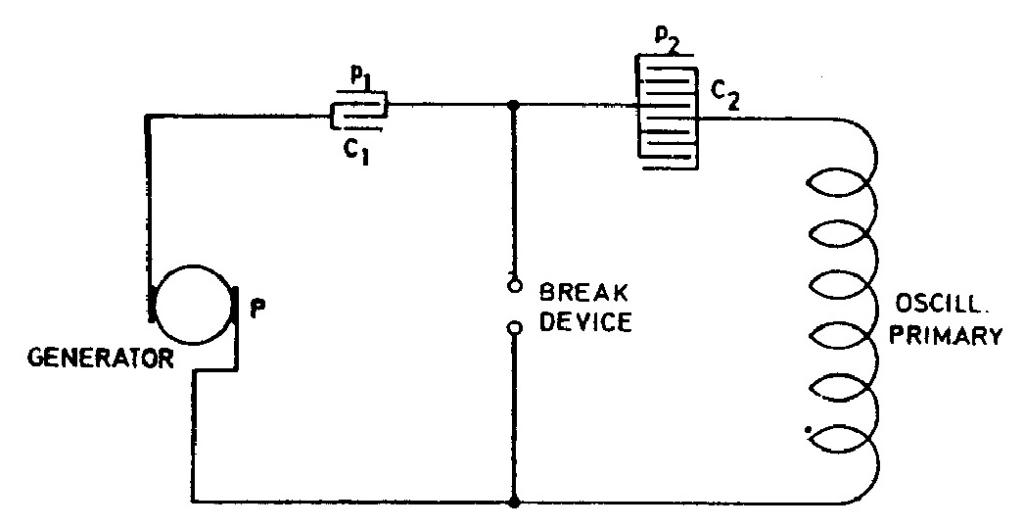
Nikola Tesla Books
Consider the following case: A condenser is connected in series with another to a generator of high tension. A circuit making and breaking device is arranged in a bridge between the condensers as illustrated in diagram. When the circuit is closed through this device the condenser included in the circuit of the generator is charged to the full potential, but when the device breaks the current path, the charge is distributed over the two condensers.
Such an arrangement with two condensers has certain valuable features in connection with oscillators, particularly when they are worked from a generator of very high and constant e.m.f. The condenser included in the generator circuit prevents short circuiting of the generator in case of defective action of the make and break device and the amount of energy drawn from the source is limited to a quantity which can be exactly determined beforehand. The arrangement is sometimes of value also with alternate current generators. The condenser C1 then performs the function of a reducing valve on a reservoir such as is used in connection with a distribution system of some gas under great pressure. By means of such an arrangement an oscillator may be worked safely from a generator of any e.m.f. and at any desired pressure. In the case as illustrated the total capacity is
$! {C = {{C_{1} C_{2}} \over {C_{1} + C_{2}}}} $!
and the energy stored by one charge in the system is
$! {{1 \over 2} p^{2} {{C_{1} C_{2}} \over {C_{1} + C_{2}}}} $!
Now $! {P = p_{1} + p_{2}} $! . . . . 1)
and $! {{{1 \over 2} p_{1}^{2} C_{1} + {1 \over 2} p_{2}^{2} C_{2}} = {{1 \over 2} p^{2} {{C_{1} C_{2}} \over {C_{1} + C_{2}}}}} $!
and from this $! {p_{1} C_{1} = p_{2} C_{2}} $! . . . . 2)
and $! {p_{1} = {PC_{2} \over {C_{1} + C_{2}}}} $! $! {p_{2} = {PC_{1} \over {C_{1} + C_{2}}}} $! . . . . 3)
Suppose the process be such that C1 first be charged to full pressure P and then disconnected and charge distributed over the two condensers, C2 being the condenser belonging to the oscillator, whereas C1 is the regulating condenser, then since
$! {{{1 \over 2}p^{2} C_{1}} = {{1 \over 2} p_{1}^{2} C_{1} + {1 \over 2} p_{2}^{2} C_{2} C_{1} (p^{2} - p_{1}^{2})} = {C_{2} p_{2}^{2}}} $! and $! {{p_{2}^{2}} = {{C_{1} \over C_{2}}(p^{2} - p_{1}^{2})}} $!
is the pressure on condenser C2 which it was the object to find.
135
August 2
A receiver of this type is mentioned in the entries of July 12th (the principle), July 28th (circuit diagram with two sensitive devices and relay), July 30th (in connection with earth waves). The transformer here has a frame similar to that of July 28th but with somewhat more turns. The sensitive device was described on July 21st.
Tesla often worked on several problems in parallel. Here for example we have entries concerning the receivers, the development of condensers for the primary of the big oscillator, and the power equation for a new configuration of the oscillator primary circuit. The condenser C1 in Fig. 2 protects the mains transformer against overload but has the drawback that it reduces the initial voltage on C2. Tesla's analysis refers to the case of two condensers in series, neglecting all transient phenomena. It may be that he was induced to think about protecting the mains transformer because of his doubts about the ability of the dielectric to stand the voltages which he intended to use.
August 2
July 12 (principal), July 28 (wiring schematic with the two sensitive devices and the relay}, July 30th (in relation with wave testing the ground). The present transformer has a similar core as the one of July 28 only now the number of turns is somewhat larger. The description of the sensitive device was given on July 21.
Tesla was frequently working at the same time on several problems. So here he first described about receivers, and then about capacitor construction for the primary of large oscillator. After that he considers the energy balance of one new connection of the oscillator primary circuit, Capacitor C1 on the Fig. 2 serves as a network transformer protection against a short circuit, but the disadvantage of it is that it reduces the initial potential on the primary capacitor C2. Tesla's analysis has been performed for the case of two capacitors while neglecting the transient events. It is possible that the capability in capacitor dielectric to withstand at the voltages he intended to use in further tests led him to decide that the protection of the network transformer was needed.


